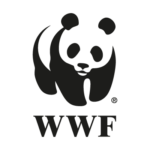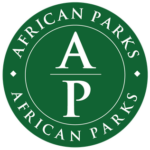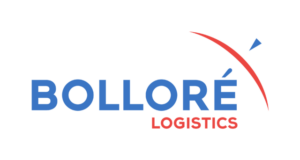The Central African Republic is a little known country in .. you guessed it .. the middle of Africa. It is just north of the two Congos and borders Chad, Cameroon, South Sudan and Sudan. It is sadly mostly known among people as one of the poorest countries in the world with an ongoing civil war and poor infrastructure. Little do people know that this country is not only rich in minerals, but also is rich in beautiful deep forest with an abundance of wildlife, unique species, a wonderful culture and great people. Its flagship is the Dzanga Sangha park which is known from BBC Africa’s Congo episode where you have the largest gathering of forest elephants filmed. The country is also great for bird watching, butterfly exploration and gorilla tracking. The rainforest is a true paradise with lots to offer and to discover. Traveling is extremely difficult, but it is possible and a truly rewarding experience. Below we have listed the most important destinations and activities in the country, in no specific order.
1. Gorilla tracking and wildlife observation at Dzanga Sangha National Park
Dzanga Sangha is located in the extreme south of the Central African Republic. It can be accessed by a combination of boat and overland driving from Cameroon or Congo or one can come from Bangui by car or chartered plane all the way down to Dzanga Sangha. It is one of the most beautiful and diverse places in all of Central Africa and in terms of beauty and wildlife experience only places such as Virunga or Ngorongoro are able to compete with this magnificent park. The park is heaven for any serious wildlife enthusiasts and birders as the park is home to many animals who seek refuge in the park. One of the highlights of the park is the Dzanga Bai where we can witness 50 up to 150 forest elephants who come to feed on the mineral rich soil of the clearance, accompanied by forest buffaloes, bongos, sitatungas, red river hogs, African gray parrots and even gorillas. Dzanga Sangha National Park is also a great place for gorilla tracking, mangabey observation, pangolins and much more. We organize gorilla tracking tours, mangabey tracking and general safari travels in Dzanga Sangha as well as other parks in Central African Republic.
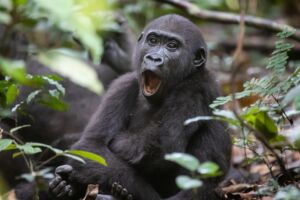
2. Net hunting with the Baka tribe
The Baka are a people living in the rainforests of Cameroon, Congo-Brazzaville, Gabon and Central African Republic. Estimates of the number of Baka range from 5,000 to 28,000. Baka reach an average length of approximately 1.5 meters. However, they do not like to be called Pygmy, but prefer to be called by their common name: Baka. The language they speak is also called Baka. This language belongs to the Adamawa-Ubangi group of the Niger-Congo language family. However, many Baka also speak Koozime, the language of the Bantu people.
The Baka are a nomadic people who live by hunting and gathering food in the rainforest. They only stay in one place as long as the food supply lasts. For centuries they built their huts from large leaves, but in recent decades they have started to copy more the “architecture” of the Bantus.
The Baka have no central authority or government, not even local leaders. All decisions are taken in joint consultation.
For this activity you go with the Baka into the forest where they put out their nets while chasing the animals by running and making calls and sound in order for them to run into the nets. It is a truly unique and special experience and a must-do if you are traveling in the Central African Republic. Net hunting can be done in Dzanga Sangha, Bayanga, Zinga and other places in the south of Central African Republic. Please, let us know if you are interested in a tour to meet the pygmy tribes and we will set it up for you.
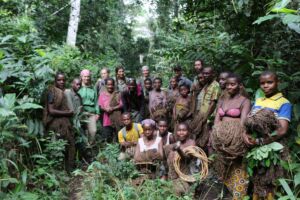
3. Have some BBQ and a cold beer near the Ubangi River in Bangui
Bangui is the capital of the Central African Republic and is located on the banks of the Ubangi River. It is worth it to stay here a little bit in combination with your safari in the Central African Republic and explore the city with its markets and nightlife. A must do is to relax near the river and have some grilled meat or fish, accompanied with a nice cold beer before you explore the city’s nightlife. Cheers!
E-mail us if you want to reserve a boat cruise on the Ubangi (Oubangi) river in Bangui with barbecue. We also rent out jetski on the Ubangi river.
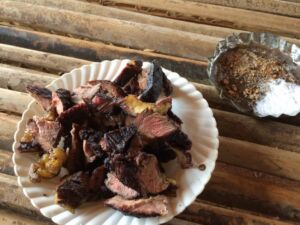
4. Zinga
The village of Zinga is located south of Bangui and is located at the confluence of the Lobaye and the Oubangui. It is a village about 1km long and 300m wide. The houses are traditional huts made from local materials (raffia palm roof and mud walls). Bordering the right bank of the Oubangui, Zinga is however distinguished by modern infrastructures inherited from its colonial past.
Indeed, the Compagnie Générale de Transport en Afrique Equatoriale (CGTAE), a river transport company, had built a six-kilometer railway, connecting the villages of Zinga and Mongo in the 1920s and whose operation ceased in 1960. This railway was a palliative to the problem of navigation on the Ubangi and the supply of the interior territory of the French colony, in particular the Ubangi-Chari and Chad. Also, it was a solution to the recurring problem of porting in Oubangui-Chari. A load break occurred during low water at the Zinga threshold, requiring a transshipment from Congo or Bangui. Goods and passengers alighted from the large steamers below the threshold and boarded smaller ones upstream in the village of Mongo.
The remains of Zinga consist of a hangar containing two locomotives, eighteen flatbed cars and two passenger cars. They also include two warehouses, two dwelling houses, the wreck of a steamboat named “Le Gouverneur Lamblin” and two boats forming the relics of the activities of this period between the wars which lasted until 1960. Docks constructed of concrete complete the installations. The Mongo terminus has two warehouses and two residential houses.
However, the degradation of the Zinga site has started. The railway does not exist any more but it is materialized by a line of dry stones which constituted its base. The wagons located on the rails in the starting position are completely oxidized just like the machines.
The hangar is also beginning to deteriorate. Its metal profile structure still supports and maintains the building.
We organize tours to Zinga in which we can take you in a modern boat on the Ubangi River all the way to Zinga, in the south of Central African Republic. During your stay we will camp near the river, eat local food, explore the villages, visit the pygmy tribes of Central African Republic and we can also go fishing for Goliath Tiger Fish and other fish.

5. Boali Waterfalls
Northwest of Bangui, on the paved road that leads to Bouar, are the famous Boali Falls (Chutes de Boali), the most famous waterfalls in Central African Republic. After crossing the hydroelectric dam which supplies the capital with electricity, the Mbali river springs up to about fifty meters in height, in a few dips that extend over more than 250 m in width. Spectacular and refreshing for a Sunday picnic and a nice day trip away from Bangui. In the dry season, you reach the bottom of the falls by a concrete staircase, long and steep. At the bottom, the water pressure has carved out small natural pools where it is possible to soak, if the ambient droplets – due to the shattering of the falls on the rocks – have not already watered you enough!
It is possible to go up the river by foot.. About fifty meters higher, a monkey bridge suspended by three cables crosses the muddy waters of the Mbali. The locals call it the “liana bridge”, but there is nothing vegetal here, except a few flickering wooden planks. On the other side of the shore, we walk in a landscape of wooded savannah, and the panorama is just as magnificent, the gaze directly overlooking the falls, with a panoramic view of the valley.
We organize day tours to the Boali Waterfalls (Chutes de Boali) in a comfortable 4×4 with a driver and a guide from Bangui. During our trip we will also stop at Crocodile Lake (Lac Aux Crocodiles), where you can see and feed crocodiles and near the Boali Falls we can also have a barbecue if you’re interested.
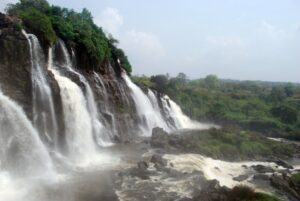
6. Chinko Nature Reserve
The Chinko Nature Reserve is located in the east of Central African Republic and is named after the Chinko River. The park has been managed by African Parks since 2014 and has since then seen great improvements after having suffered horribly from poaching and violence in the past few decades. The park is now thriving again and there are many species which can be observed. There is a small camp in the park which can be reached by chartered flight and from where you can explore the park or go fishing for the Goliath Tigerfish. We organize tours to Chinko in which we go to the park by chartered plane and typically stay 4 to 7 days in the park. It is also possible to do Goliath tigerfish fishing in Chinko. Send us an e-mail if you want more information about a travel for tiger fishing or safari.

7. Bouar Megaliths
Located 452 km northwest of Bangui, Bouar is the capital of Nana-Mambéré. It is here, in the heart of the Gbaya country, that the French had set up a military base, the famous FAO. The entire economy, and more broadly the entire urban organization, has therefore been designed according to the needs and pace of life of the military. The rows of trees which delimit the streets and open up perspectives, the opulent colonial villas which line up proudly in the highest altitude districts bear witness to this time when Bouar was a popular holiday resort for the French in the Central African Republic. The Bangui-Bouar road was then quite passable (one must imagine the Citroën traction convoys crossing the country without difficulty) and Bouar even had a direct air link with Paris.
Much has changed since the departure of the French military in 1978. The city seems neglected. Just like this once prestigious modern high school. The paved road in the center and on the hill has become impassable. The few barracks still standing are occupied by Central African soldiers, and the houses built by settlers, of which only the foundations remain, inhabited by officials. However, Bouar certainly remains one of the pearls of the Central African Republic. A living museum of the colonial era, dotted with large gray pebbles which give it an indefinable charm, the city, perched on a hill, offers an air less suffocating than in Bangui, and breathtaking views over the valley which winds its way up to Cameroon. Many walks are possible in the surrounding nature, discovering waterfalls, or fishing in the surrounding rivers.
Christian missions are numerous in the area (Catholics, Adventists, Lutherans, Baptists …). The three seminars (diocesan, Carmelite, Capuchin) gathered at La Yolé are worth a visit: for more than 200 children, they form a privileged place of study, but also a place of agro-pastoral experimentation; in addition, they house in a museum, which deserves to be dusted off, fitted out and embellished with a few presentations, very interesting collections of masks and traditional handicrafts. Finally, the city has a unique heritage made up of its megaliths. Huge stones (a kind of menhirs) that can reach up to 5 m in height, they bear witness to a civilization of the final stone age, which had settled on the site of Bouar 25 centuries ago.
We organize tours to Bouar which can be combined with visiting other sites. We go in a comfortable car from Bangui with a driver and will take care of your hotel in Bouar and your activities.
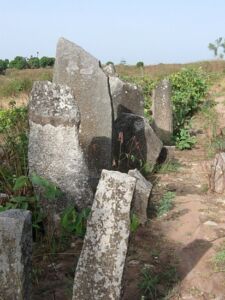
8. Lobaye
Lobaye is a region in the Central African Republic which has many pygmy tribes. As the area is less than 100 kilometer from the capital Bangui it is therefore interesting to add to your itinerary when you come visiting the country. The region is also known for its coffee and it’s possible to visit the plantations and get to know everything about the cultivation. We organize tours from Bangui by car to Lobaye with a visit to the Baka (Ba’Ka) tribes and visiting the coffee plantations.
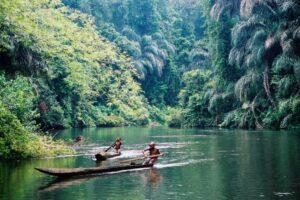
9. Mbaiki
Located 107 km from Bangui, Mbaïki “la fleurie” also signals the end of the tar. It is accessed by a road eaten up by holes, where the asphalt often looks like Swiss cheese. Prefecture of Lobaye, Mbaïki is located on the RN6 which leads to the 4th parallel. This road had been built and paved at the time of Bokassa, to convey goods to the 4th parallel, towards the southwest area and Cameroon. The main economy in the city is based on coffee and timber and travelers can learn about both whilst visiting. Let us know if you are interested in visiting Mbaiki and we can set up your travel to Mbaiki with a comfortable car with driver and arrange your hotel and activities.
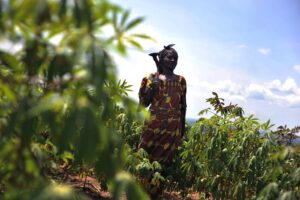
10. Fishing for Goliath Tiger fish in the Central African Republic
Hidden in the deep waters of the Oubangi (Ubangi) River we can find the deadly Goliath Tiger Fish. One of the meanest ugliest predators roaming the waters in Africa and a true sought after price for all serious sports fishermen. The biggest tiger fish, called Goliath Tiger Fish or Mbenga / Mbinga live in Congo and the Central African Republic on the Ubangi and Congo River. We organize tours in which we take you to our secret fishing spots in a very comfortable big boat with two engines of 130 horsepower and a crew and an experienced fishing guide. We can combine your fishing tour in the Central African Republic with a tour on the Congo River where we take you to all the best spots along the river and not only search for the Goliath Tiger Fish, but also giant catfish, huge lungfish which go out of the water to hunt, eels and other giant beasts. For these trips we can go anywhere from 5 days to 2 or 3 weeks along the river and camp on the banks of Ubangi and Congo River and we can take you all the way to Brazzaville or Kinshasa by boat. This is the last truly big fishing adventure of Africa.
Let us know if you want to book a fishing tour and fish Goliath Tiger Fish with our local company Central African Republic Travel and tours and we can customize your fishing itinerary on the Ubangi and Congo River.







